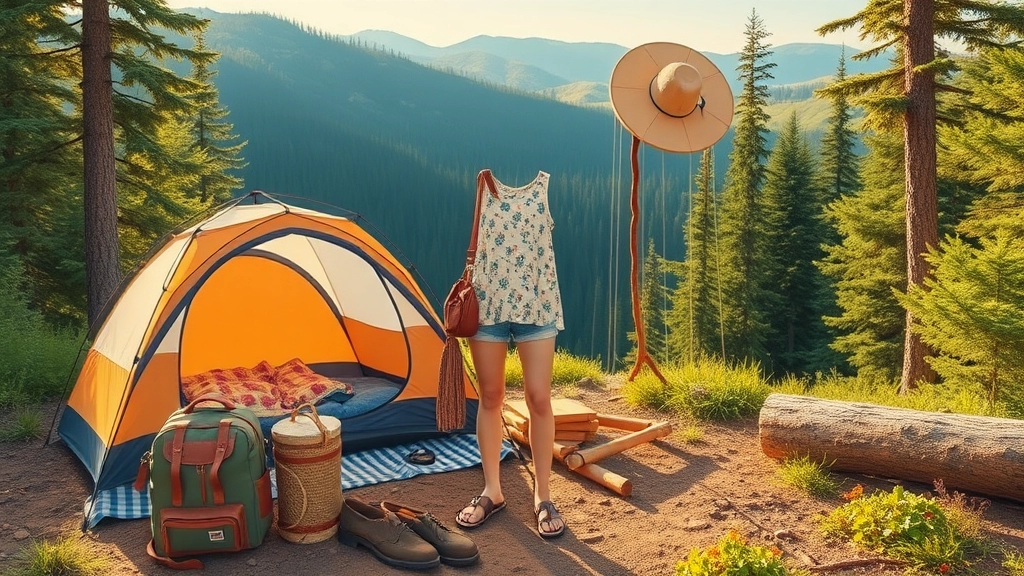Planning Your Summer Camping Outfit
Planning a summer camping trip and unsure about what to wear? You’re not alone. In this article, we’ll explore the essential features of a perfect summer camping outfit that balances comfort, style, and functionality. From breathable fabrics to insect-repellent gear, we’ve got you covered for all the unpredictable elements of the great outdoors.
Essential Features of Summer Camping Clothes
We’ll dive into the best materials for summer camping clothes, discuss the importance of lightweight layers, and highlight stylish yet functional hiking attire. Plus, we’ll cover waterproof and quick-drying clothing for those unexpected rain showers, footwear choices for rough terrain, and must-have accessories like hats and sunglasses.
Get Ready for Your Adventure
Ready to pack smart and enjoy your summer camping trip to the fullest? Let’s get started!
Essential Features of Summer Camping Outfits
Ever stood in front of your wardrobe, wondering what on earth to pack for a summer camping trip? You’re not alone. Let’s dive into the essential features of summer camping outfits that’ll keep you comfy, stylish, and ready for anything the wild throws your way.
What Makes a Great Summer Camping Outfit?
When it comes to camping, your outfit needs to do more than just look good. It’s got to perform. Here’s what I look for:
- Breathability: No one wants to feel like they’re wrapped in cling film. Fabrics that breathe are a must.
- Moisture-Wicking: Sweat happens. Choose materials that pull moisture away from your skin.
- Lightweight: You’re carrying enough with your gear, so keep your clothes light.
- Durability: The great outdoors can be rough. Your clothes need to withstand a bit of wear and tear.
- Versatility: Pieces that can transition from day to night or from hiking to lounging are gold.
Why These Features Matter
Imagine trekking through the woods in a heavy, non-breathable outfit. You’d be drenched in sweat and miserable. On the flip side, a lightweight, breathable ensemble keeps you cool and comfortable. It’s like having a secret weapon against the elements.
Real-Life Example
Last summer, I packed a pair of moisture-wicking shorts and a breathable T-shirt for a weekend trip. When the sun blazed down, I stayed cool. When the evening chill set in, I simply added a lightweight jacket. It was a game-changer.
Quick Tips for Choosing the Right Outfit
- Opt for Layers: Mornings and evenings can be chilly. Bring a lightweight fleece or jacket.
- Choose Neutral Colours: They hide dirt and match everything.
- Pack Multi-Functional Items: A scarf can double as a headband or blanket.
The right summer camping outfit can make or break your trip. Keep these features in mind, and you’ll be ready for anything. Whether you’re hiking, lounging, or caught in a surprise rain shower, your outfit should have your back. For more tips on making the most of your summer camp experience, check out our Summer Camp Cabin Guide and explore the best summer camp themes for unforgettable fun.
Best Materials for Summer Camping Clothes
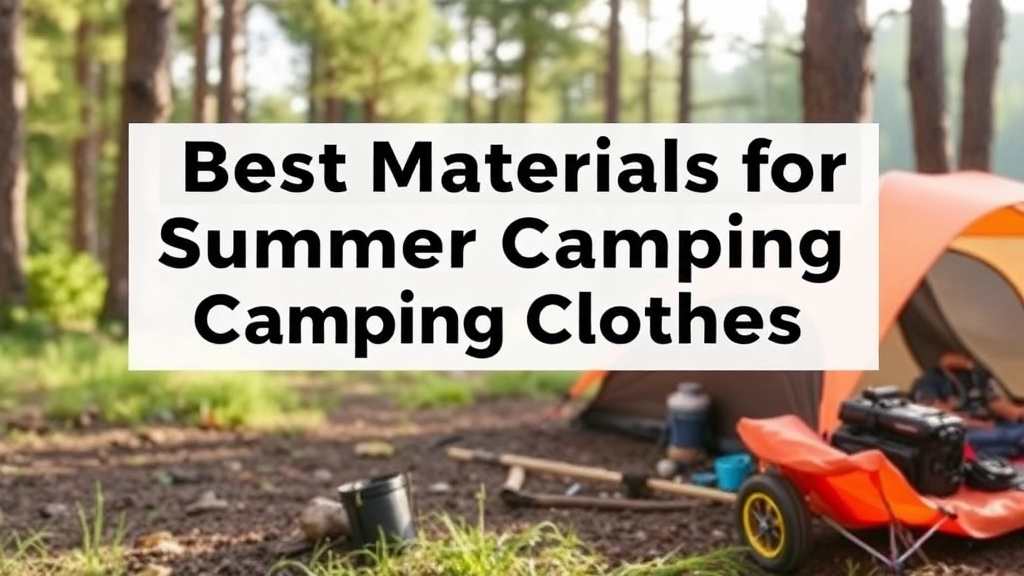
Alright, let’s get into it.
What’s the best material for summer camping clothes?
I get it, you want to stay cool, comfortable, and not smell like a gym bag.
Here’s the lowdown:
1. Breathable Fabrics
You don’t want to be drenched in sweat.
Look for materials like cotton blends and linen.
They let your skin breathe.
2. Moisture-Wicking
Nobody likes feeling sticky.
Polyester and nylon are your friends here.
They pull sweat away from your body, keeping you dry.
3. Quick-Drying
Ever been caught in a sudden downpour?
You need clothes that dry fast.
Synthetic fabrics like polyester and nylon excel at this.
4. Lightweight and Packable
You don’t want to lug around heavy gear.
Opt for lightweight materials like merino wool.
Yes, wool.
It’s not just for winter.
Merino wool is breathable and odour-resistant.
5. UV Protection
Sunburns? No, thanks.
Look for clothes with built-in UV protection.
Some fabrics come with a UPF rating.
The higher, the better.
6. Durability
Camping can be rough.
You need clothes that can handle it.
Ripstop nylon is tough and resistant to tearing.
Real Talk:
Ever been on a hike and felt like your clothes were suffocating you?
I have.
Switched to moisture-wicking and breathable fabrics.
Game changer.
Quick Tips:
- Cotton for lounging, not for hiking.
- Polyester/Nylon for active wear.
- Merino Wool for versatility.
Why does it matter?
Because you want to enjoy your trip, not be constantly adjusting your clothes.
Lightweight Layers for Morning and Evening Cool
Ever been camping and found yourself shivering as the sun sets or before it rises? Yeah, me too. It’s a common worry, especially when you’re trying to pack light for a summer camping trip. You don’t want to lug around a ton of clothes, but you also don’t want to freeze your tail off. So, what’s the solution? Lightweight layers. Let’s dive into why they’re essential and how to choose the best ones.
Why Lightweight Layers Matter
First off, let’s talk about why you need lightweight layers. When you’re out camping, temperatures can swing dramatically between day and night. During the day, it might be blazing hot, but as soon as the sun dips, you could be reaching for an extra layer. Lightweight layers are your best friend here because they:
- Trap Heat: They keep your body heat in without making you feel like you’re in a sauna.
- Pack Small: They don’t take up much space, so you can pack a few without overloading your backpack.
- Versatile: You can mix and match them depending on the temperature, making them super versatile.
Best Materials for Lightweight Layers
Choosing the right materials is crucial. You don’t want to end up sweaty and uncomfortable. Here are some top picks:
- Merino Wool: This is a game-changer. It’s breathable, moisture-wicking, and keeps you warm even when it’s wet.
- Synthetic Fabrics: Think polyester or nylon. They dry quickly and are usually more affordable.
- Fleece: Perfect for those chilly mornings and evenings. It’s lightweight and provides excellent insulation.
Layering Tips for Maximum Comfort
Now, let’s get practical. How do you layer up without feeling like the Michelin Man?
- Base Layer: Start with a moisture-wicking base layer. This keeps sweat off your skin, so you stay dry and warm.
- Mid Layer: Add a lightweight fleece or merino wool sweater. This traps heat close to your body.
- Outer Layer: If it’s really cold, throw on a windbreaker or light jacket. Make sure it’s breathable so you don’t overheat.
Real-Life Example
I remember this one time I went camping in the Lake District. The weather was all over the place. One minute it was sunny, and the next, it felt like I was in the Arctic. My saving grace? A lightweight merino wool sweater. It kept me warm during those chilly mornings and didn’t make me sweat when the sun came out.
Internal Links for More Tips
- Summer Camping Essentials: Dive deeper into why merino wool and synthetic fabrics are your best bet.
- Top Tips and Gear Essentials for Summer Camping: Check out how to stay comfy during the day while still being prepared for those temperature drops.
Stylish and Functional Hiking Attire
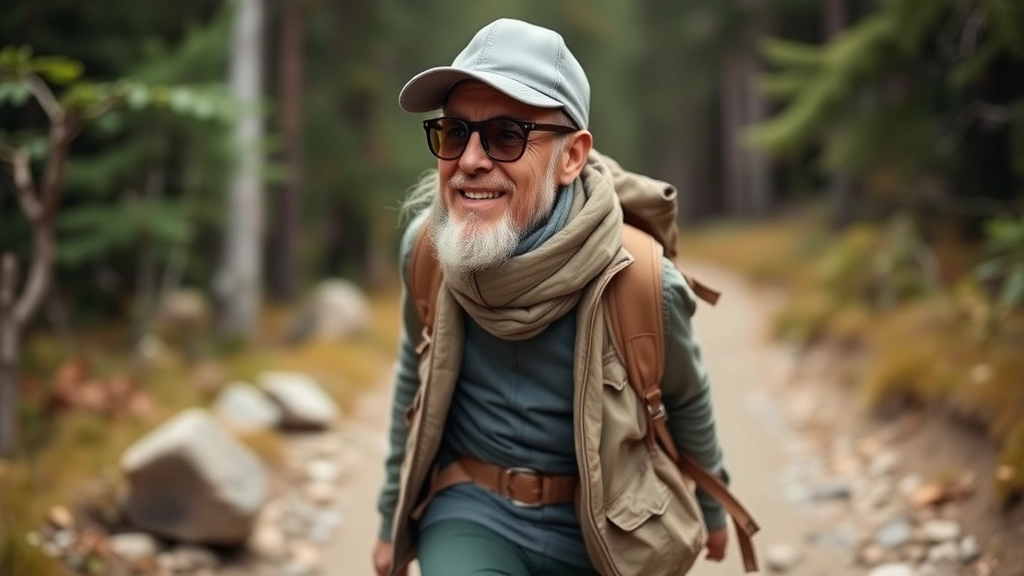
Ever wonder how to look good and feel great while hiking?
It’s not just about style—it’s about function too.
Let’s dive into what makes the perfect hiking outfit.
What to Wear for Hiking?
First off, comfort is key.
You want gear that moves with you, not against you.
But who says you can’t look good too?
Here’s what I go for:
- Breathable Fabrics: Think moisture-wicking materials like polyester or merino wool. Keeps the sweat at bay.
- Stretchy Trousers: Flexibility is your friend. You need to climb and stride without restrictions.
- Lightweight Jacket: A windbreaker or light fleece for those unexpected chills.
Balancing Style and Function
Now, let’s talk style.
You don’t have to sacrifice it for functionality.
Consider these tips:
- Colour Coordination: Earth tones or vibrant colours—choose what suits your vibe.
- Layer Up: A well-layered look not only keeps you warm but also looks sharp.
- Accessories: A stylish hat or bandana can add flair and keep the sun off your face.
Real Talk: What Works and What Doesn’t
I once wore a cotton shirt on a hike.
Big mistake.
It got soaked, heavy, and uncomfortable.
Learn from my blunder—stick to quick-drying materials.
Why This Matters:
- Comfort: You’ll enjoy the hike more when you’re not fussing with your clothes.
- Confidence: Looking good boosts your mood and energy.
- Performance: Proper gear enhances your hiking experience.
Comfortable Daytime Camping Outfits
Are you tired of feeling sticky and uncomfortable during your daytime camping adventures? You’re not alone. We all want to look good and feel great while exploring the great outdoors. So, let’s dive into the essentials of putting together the perfect daytime camping outfit that keeps you comfy and stylish.
Why Comfort Matters
When you’re out in the wild, comfort is king. You don’t want to be tugging at your clothes or feeling restricted while climbing over rocks or setting up your tent. Here’s what you should focus on:
- Breathable Fabrics: Look for materials like cotton, linen, or moisture-wicking synthetics. These fabrics help you stay cool and dry.
- Flexible Fit: Go for clothes that offer some stretch. Think about activities like hiking, fishing, or even just lounging by the campfire. You need freedom to move.
- Layering: Even during the day, temperatures can fluctuate. Lightweight layers let you adjust easily.
Top Choices for Daytime Camping Outfits
Let’s break it down piece by piece.
Tops:
- Moisture-Wicking T-Shirts: These are your best friends. They pull sweat away from your body and dry quickly.
- Lightweight Long-Sleeve Shirts: For sun protection and to avoid scratches from branches or insects.
Bottoms:
- Convertible Trousers: These can be zipped off into shorts. Perfect for those unpredictable weather changes.
- Comfortable Shorts: Look for options with plenty of pockets for your gear.
Footwear:
- Hiking Boots: Essential if you’re hitting rough terrain.
- Sandals or Trainers: For more relaxed activities around the campsite.
Accessories:
- Hats: A wide-brimmed hat can shield you from the sun.
- Sunglasses: Protect your eyes from UV rays.
- Sunscreen: Not clothing, but just as important. Apply generously.
Real Talk: What Works and What Doesn’t
I’ve seen people make all sorts of mistakes when it comes to camping attire. One time, a buddy of mine showed up in jeans and a heavy cotton t-shirt. By midday, he was drenched in sweat and miserable. Don’t be that guy.
Instead, think about what you need for the day ahead. Are you going to be hiking? Fishing? Just chilling? Tailor your outfit to your plans.
Quick Tips for Packing
- Roll, Don’t Fold: Rolling your clothes saves space and reduces wrinkles.
- Pack Multi-Functional Items: A bandana can serve as a head cover, a towel, or even a makeshift sling.
- Use Packing Cubes: These help keep your gear organised and easy to find.
For more tips on making the most of your camping experience, check out our Top Tips and Gear Essentials for Summer Camping and our Ultimate Guide to Summer Camp Layout Design.
Waterproof and Quick-Drying Clothing for Unexpected Rain
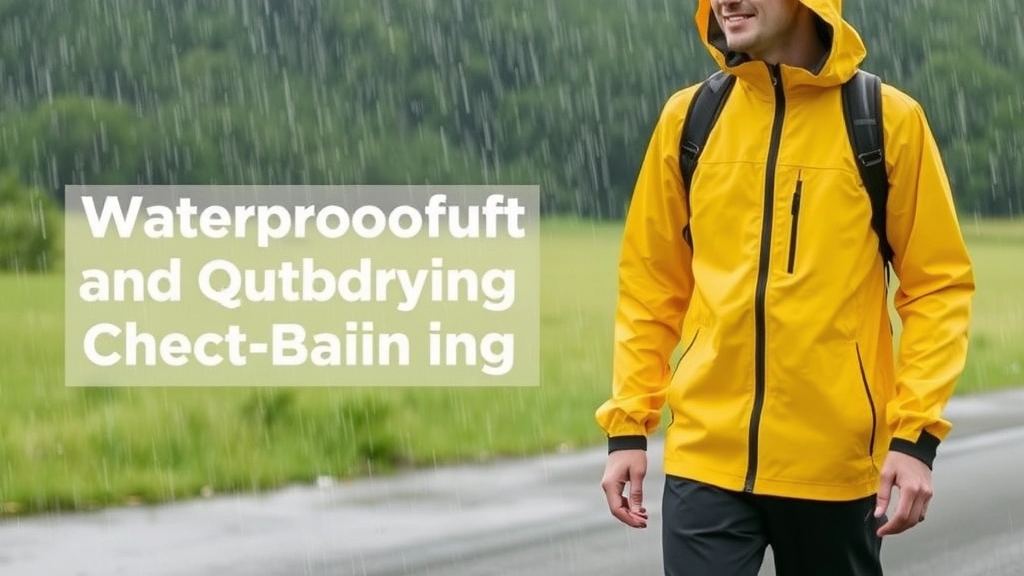
Ever been caught in a summer downpour while camping? It’s a real buzzkill, right?
But hey, it happens.
And when it does, you want to be ready with waterproof and quick-drying clothing.
Let’s dive into some tips to keep you dry and comfy.
Why Waterproof and Quick-Drying?
First off, let’s talk about why these features are non-negotiable.
Waterproof gear keeps the rain out, so you don’t end up soaked and miserable.
Quick-drying fabrics ensure that even if you do get wet, you’re not stuck in damp clothes all day.
What to Look For
When shopping for waterproof and quick-drying clothing, keep these points in mind:
- Material Matters: Look for fabrics like nylon and polyester. They dry faster than cotton.
- Sealed Seams: Make sure your waterproof gear has sealed seams to keep the water out.
- Breathability: You don’t want to feel like you’re in a sauna. Look for breathable options that allow moisture to escape.
Must-Have Items
Here’s a quick list of essential waterproof and quick-drying items for your camping wardrobe:
- Rain Jacket: Lightweight, packable, and with a hood. Perfect for those sudden showers.
- Quick-Dry Trousers: Convertible ones are great. Zip off the legs when it gets warm.
- Waterproof Footwear: Think hiking boots or trail shoes with good grip.
- Moisture-Wicking Base Layers: These keep sweat away from your skin, so you stay dry from the inside out.
Real Talk: Personal Experience
Let me share a quick story.
I once got caught in a torrential downpour on a camping trip.
I was wearing a cheap, non-waterproof jacket.
Big mistake.
I was soaked to the bone and freezing.
Now, I never go camping without my trusty waterproof gear.
Learn from my mistake.
Packing Tips
When packing for your trip, keep these tips in mind:
- Roll, Don’t Fold: Rolling your clothes saves space and keeps them wrinkle-free.
- Stuff Sacks: Use waterproof stuff sacks to keep your gear dry.
- Layer Up: Pack lightweight layers that you can easily add or remove as the weather changes.
Got any other tips or stories about camping in the rain? Share them below!
And if you’re looking for more camping outfit tips, check out our other sections on stylish hiking attire and comfortable daytime camping outfits.
Footwear Choices for Rough Terrain and Campsite Comfort
Alright, let’s talk about something that can make or break your camping experience: footwear choices for rough terrain and campsite comfort. We’ve all been there, right? You’re halfway through a hike, and your feet are killing you, or you’re sitting around the campfire, and your toes are freezing. Not fun. So, how do we fix this? Let’s dive in.
The Right Footwear for the Job
When it comes to camping, your footwear needs to be versatile. Here’s what you need to consider:
- Hiking Boots:
- Ankle Support: Essential for rough terrain to avoid those nasty twists and sprains.
- Waterproof: Because no one likes soggy socks.
- Breathable: Keep those feet dry and comfy.
- Trail Running Shoes:
- Lightweight: Perfect for those who prefer speed and agility.
- Cushioned Soles: Great for absorbing shock on rocky paths.
- Quick-Drying: Ideal if you’re crossing streams or dealing with morning dew.
- Camp Shoes:
- Slip-Ons or Sandals: Easy to put on and take off.
- Comfortable: After a long day of hiking, your feet deserve a break.
- Durable: Can handle a bit of rough ground around the campsite.
Real Talk: What Works and What Doesn’t
I once made the mistake of wearing my regular trainers on a camping trip. Big mistake. By the end of the first hike, my feet were blistered, and I was miserable. Don’t be like me. Here’s what you need to keep in mind:
- Break Them In: Never, and I mean never, go camping with brand-new shoes. Wear them around the house, take them on short walks, whatever it takes to make them comfortable before your trip.
- Socks Matter: Invest in good-quality hiking socks. Wool or synthetic blends are your friends here. They wick away moisture and provide cushioning.
- Insoles: If your boots or shoes don’t come with good insoles, buy them separately. Trust me, your feet will thank you.
Quick Tips for Choosing the Best Footwear
Here’s a quick checklist to make sure you’re picking the right footwear:
- Fit: Snug but not tight. You should have enough room to wiggle your toes.
- Weight: Lighter is usually better, but don’t sacrifice support.
- Traction: Look for soles with good grip to avoid slips and falls.
- Versatility: Can they handle both hiking and lounging around the camp?
Footwear Maintenance
Your boots and shoes are an investment, so take care of them:
- Clean Them: After each trip, remove dirt and debris.
- Dry Them: Never store them wet. Stuff them with newspaper to absorb moisture.
- Inspect Them: Check for wear and tear. Replace laces and insoles as needed.
For more tips on making your camping experience enjoyable, check out our guide on summer camping gear tips and fun activities. If you’re planning to camp in Texas, don’t miss our article on summer camping hotspots in Texas for the best locations.
Accessories: Hats, Sunglasses, and Sun Protection
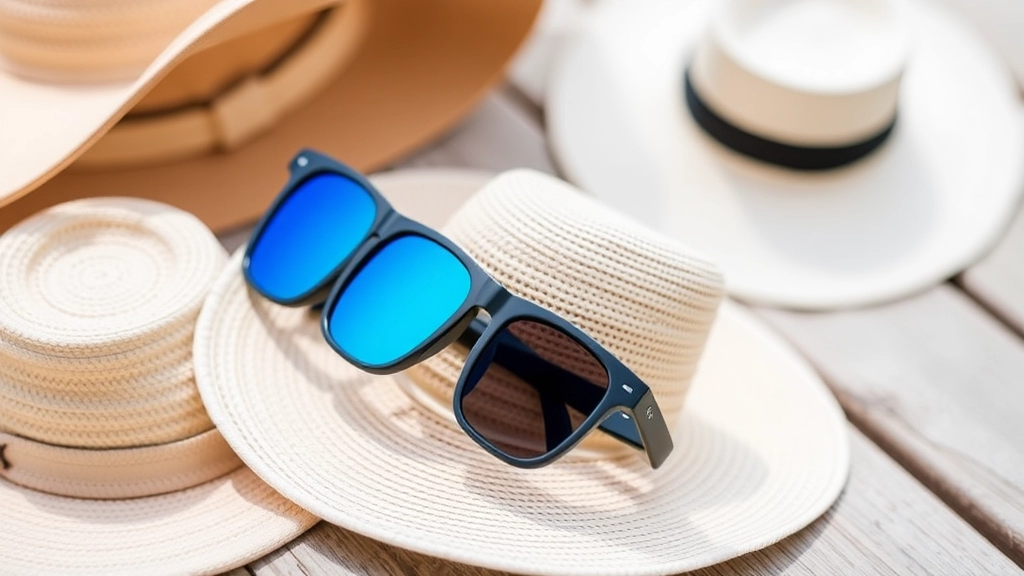
Ever been on a summer camping trip and ended up with a sunburnt nose or squinting through the entire hike?
Yeah, me too.
Let’s talk about the essential accessories that’ll keep you cool and protected.
Why Hats Are a Must-Have
Hats are more than just a style statement. They shield your face and neck from the sun’s harsh rays. Here’s what to look for:
- Wide Brim: Covers more area, providing better protection.
- Breathable Fabric: Keeps your head cool.
- Adjustable Straps: Keeps the hat in place, even on windy days.
Sunglasses: Not Just for Looks
Sunglasses protect your eyes from UV rays and reduce glare. Make sure they offer:
- UV Protection: Blocks harmful rays.
- Polarised Lenses: Reduces glare, especially near water.
- Durability: Can withstand rough outdoor conditions.
Sun Protection: More Than Just Sunscreen
Sunscreen is essential, but let’s not stop there. Consider these additional layers of protection:
- UPF Clothing: Clothes with Ultraviolet Protection Factor.
- Neck Gaiters: Protects your neck and can be pulled up to cover your face.
- Lip Balm with SPF: Often overlooked but crucial.
Real Talk: My Personal Favourites
I once forgot my hat on a trip and ended up with a nasty sunburn. Since then, I’ve always packed:
- A wide-brimmed hat with a chin strap.
- Polarised sunglasses that wrap around my face.
- UPF-rated shirts that are lightweight but protective.
Quick Tips for Packing Your Accessories
- Keep it Lightweight: Choose items that are easy to pack and carry.
- Multi-Functional: Look for accessories that serve more than one purpose.
- Easy to Access: Keep these items in an easily accessible part of your backpack.
Insect-Repellent Clothing and Gear
Alright, let’s talk about something that can make or break your summer camping experience: insects. No one wants to spend their trip swatting at mosquitoes or dealing with itchy bites. So, how do you keep those pesky bugs at bay? The answer lies in insect-repellent clothing and gear. If you’re asking yourself, âIs insect-repellent clothing really necessary?â or âWhat’s the best gear to avoid bites?â, you’re in the right place.
Why You Need Insect-Repellent Clothing
First off, let’s get real. Insects aren’t just annoying; they can also be dangerous. Mosquitoes can carry diseases like West Nile virus, and ticks can transmit Lyme disease. So, having the right gear isn’t just about comfort; it’s about safety.
Key Features to Look For
When you’re shopping for insect-repellent clothing, here’s what you need to keep an eye out for:
- Permethrin-Treated Fabric: This is a game-changer. Permethrin is a synthetic insecticide that’s safe for humans but deadly for bugs. Clothes treated with it can repel mosquitoes, ticks, and other insects.
- Long Sleeves and Pants: More coverage equals fewer bites. Look for lightweight, breathable options so you don’t overheat.
- Close-Fitting Cuffs: Elastic or drawstring cuffs can keep insects from sneaking up your sleeves or pant legs.
- Light Colours: Insects are less attracted to light colours, plus they help you stay cool.
Must-Have Insect-Repellent Gear
Besides clothing, there are a few other essentials you’ll want to pack:
- Insect-Repellent Spray: Even with treated clothing, a good spray can offer extra protection. Look for options with DEET or picaridin.
- Mosquito Net: If you’re camping in a high-risk area, a mosquito net for your sleeping area is a must.
- Bug-Repellent Wristbands: These are great for added protection and are easy to wear.
Real Talk: My Experience
I remember one summer camping trip where I thought I could get by with just regular clothes and a bit of bug spray. Big mistake. I ended up with so many bites that I spent more time scratching than enjoying the outdoors. Since then, I’ve switched to permethrin-treated clothing and haven’t looked back. Trust me, it’s worth it.
Packing Tips
When you’re packing for your trip, keep it simple but effective. Here’s a quick checklist:
- Permethrin-treated long-sleeve shirt and pants
- Lightweight, breathable socks
- Insect-repellent spray
- Mosquito net
- Bug-repellent wristbands
For more tips on how to make your summer camp experience enjoyable and safe, check out our summer camp lesson plans and discover the top adventure summer camps for kids and teens.
Easy-to-Pack Summer Camping Outfit Essentials
Ever packed for a camping trip and ended up with a bag heavier than a small child?
Yeah, me too.
Packing light is the name of the game, especially for summer camping.
But how do you decide what to bring without sacrificing comfort or style?
Let’s break it down.
Must-Have Essentials
First things first, pack smart.
Here are some essentials you can’t go without:
- Moisture-Wicking T-Shirts: Keeps you dry and cool.
- Convertible Pants: Zip-off legs for when it gets hot.
- Lightweight Jacket: For those chilly mornings and evenings.
- Quick-Dry Shorts: In case you get caught in a sudden downpour.
- Comfortable Footwear: Hiking boots for the trails and sandals for the campsite.
Why These Essentials?
You want items that are multi-functional and easy to pack.
For instance, those moisture-wicking t-shirts?
They double as sleepwear.
And those convertible pants?
Perfect for unpredictable weather.
Packing Tips
Now, let’s get into the nitty-gritty of packing.
- Roll, Don’t Fold: Rolling your clothes saves space and reduces wrinkles.
- Use Packing Cubes: Keeps things organised and easy to find.
- Limit Your Colours: Stick to a neutral colour palette so everything matches.
Real Talk
I once packed four pairs of jeans for a camping trip.
Big mistake.
Not only did they take up half my backpack, but they were also heavy and took forever to dry after a surprise rainstorm.
Learn from my mistake: pack light, pack smart.
Accessories
Don’t forget your accessories:
- Hat and Sunglasses: For sun protection.
- Bandana: Multipurpose, can be used as a headband, neck cover, or even a makeshift towel.
- Insect-Repellent Clothing: Trust me, you don’t want to be swatting bugs all day.
For more tips on what to bring and how to prepare, check out our Ultimate Checklist for Packing for Summer Camp. And if you’re looking for some fun activities to do once you’re all packed, don’t miss our Ultimate Guide to Summer Camp Bonfire Fun.
FAQs on Summer Camping Outfits
What are the best materials for summer camping clothes?
For summer camping, you should look for breathable fabrics like cotton blends and linen, moisture-wicking materials such as polyester and nylon, and quick-drying fabrics. Additionally, lightweight and packable materials like merino wool, which is also odour-resistant, are excellent choices.
Why is UV protection important in camping clothes?
UV protection in camping clothes is crucial to prevent sunburns. Look for clothes with built-in UV protection and a high UPF rating to shield your skin from harmful UV rays.
What should I wear for hiking to balance style and function?
Comfort and functionality are key. Opt for breathable fabrics like polyester or merino wool, stretchy trousers for flexibility, and a lightweight jacket for unexpected chills. For style, consider colour coordination, layering, and accessorizing with a stylish hat or bandana.
What are the must-have items for waterproof and quick-drying clothing?
Essential items include a lightweight rain jacket with a hood, quick-dry trousers, waterproof footwear like hiking boots, and moisture-wicking base layers. These items will keep you dry and comfortable even in sudden downpours.
Why are hats and sunglasses important accessories for summer camping?
Hats provide essential protection for your face and neck from the sun, while sunglasses protect your eyes from harmful UV rays and reduce glare. Look for hats with a wide brim, breathable fabric, and adjustable straps, and sunglasses with UV protection and polarised lenses.
What additional sun protection should I consider besides sunscreen?
In addition to sunscreen, consider wearing UPF clothing, using neck gaiters to protect your neck and face, and applying lip balm with SPF. These additional layers of protection will help keep you safe from the sun’s harmful rays.
How should I pack my accessories for a camping trip?
When packing accessories, choose lightweight items that are easy to carry, look for multi-functional accessories, and keep them in an easily accessible part of your backpack for quick access.
What are some quick tips for choosing the right camping outfit?
For camping outfits, use cotton for lounging but avoid it for hiking. Choose polyester or nylon for active wear and merino wool for versatility. These materials will ensure you stay comfortable and dry during your trip.
Why does choosing the right camping outfit matter?
Wearing the right camping outfit enhances your overall experience by ensuring comfort, boosting confidence, and improving performance. You’ll enjoy your trip more when you’re not constantly adjusting your clothes or feeling uncomfortable.
References
-
What to Wear Hiking: Expert Advice from REI
-
How to Choose the Best Hiking Clothes by Outdoor Research
-
Best Hiking Clothes of 2024 by Switchback Travel

